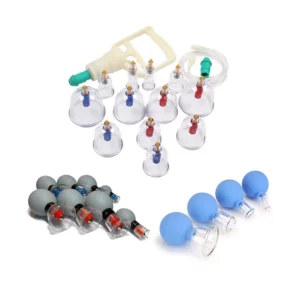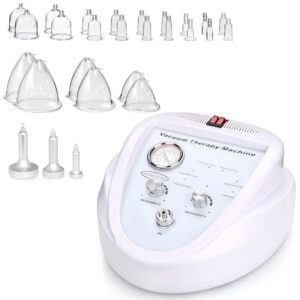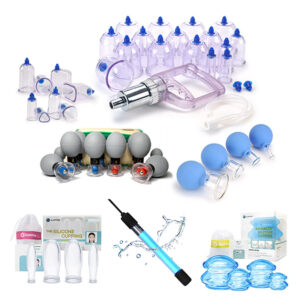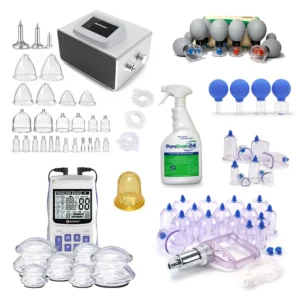Your cart is currently empty!
Vacuum Therapies for Surgical Preparation and Recovery
By Anita J. Shannon, LMBT and Rita Woods, LMT
Originally published in Massage Today, August, 2013, Vol. 13, Issue 08.
Surgery can be one of the most traumatic, yet helpful, events that a person can undergo. Proper preparation and effective techniques for recovery can make a world of difference in the experience.
Vacuum therapies present a successful path to integration with the medical community, and allow us to work directly with the surgeons and have access to diagnostic reports.
Preparation for surgery includes vacuum therapies to drain and clear lymphatic pathways, decongest the tissues, and release any soft tissue restrictions to movement of muscles and fascia or flow of blood and lymph. Post-surgical care includes the same approach, and adds in potential scar work to diminish appearance and adhesions, along with release of inflammation, pockets of anesthesia, and soft tissue issues that may have resulted from surgical positioning.
Surgical complications often include the formations of adhesions, nerve compression damage and reactions to the anesthesia. While any adhesion is a potential restrictive problem, abdominal adhesions are a particularly burdensome complication. They form in approximately 90% of all patients undergoing any type of abdominal surgery, but the risk is greater for operations on the lower abdomen including pelvic, bowel and gynecological surgeries.
These surgery induced adhesions can be caused by tissues incision, especially those involving internal organs, the handling of organs, the drying out of internal organs and tissues, contact of the internal tissues with foreign materials such as gauze, surgical gloves, stitches, etc., as well as blood or blood clots that were not rinsed out during surgery. Abdominal adhesions are bands of tissue that form between tissues and organs causing them to adhere and stick together. They can become larger and tighter as time passes causing problems years after surgery.
Other less common, but just as serious, causes of abdominal adhesions involve inflammation from sources not related to surgery including appendicitis- in particular appendix rupture, radiation for cancer treatment, gynecological infections and abdominal infections. The use of vacuum therapies is extremely effective in working with these scars and adhesions, with very little discomfort for the client.
Prolonged surgeries in which the body has been placed and maintained in an unnatural position can lead to peripheral nerve damage. While the cause of damage varies, it can range in severity from mildly annoying to disabling. In most cases, the damage is temporary and the discomfort or numbness decreases in the weeks following surgery. But a small percentage of patients have lasting nerve problems. Decompressing the involved area with vacuum therapies relieves the pressure and allows the tissue to return more quickly to a normal state. Damage can also occur at the site where medications were injected or at the site of a spinal epidural.
Another potential complication of surgery relates to the anesthesia. Most problems arise from the use of general anesthesia (when the patient is put to sleep) but some problems may arise with local or regional anesthesia- usually at the site of medication injection as mentioned above.
General anesthesia, however, can foster a whole different set of problems. Two separate studies, one from Sweden and one from Duke University, showed that the length of time spent under deep anesthesia is a significant risk factor for predicting death up to two years after surgery. In both studies, the common cause of those deaths after surgery (non cardiac surgeries), were primarily from heart attacks or cancer. Additionally, a subsequent study indicated a cognitive decline in elderly patients up to two years following surgery. One popular theory as to why this happens is based on the production of inflammatory neurochemicals that negatively impact the body and undermine the immune system. One of the key uses of vacuum therapies involves the ability move fluids and clear the body of toxins and inflammatory residue.
The most incredible aspect of this work for preparation and recovery from surgical issues is the decompression that the vacuum produces. The lifting and stretching of the tissue and the release of restrictions, as well as the drainage and clearing of debris creates space and the opportunity for the body to resume normal functioning.
Protocols for each client will depend on a thorough intake and review of supporting documentation from the surgeon (if possible), and then the application of a six-step evaluation and tracking criteria that we developed over years of creating protocols using vacuum therapies. Recovery techniques can be used on clients of any age, and can produce some surprising results on sites that are quite old.
A recent experience while teaching in France was the perfect opportunity to show the class how the age of a scar can determine the techniques used to treat it, yet the results were dramatic with both examples. A wonderful German man who was also a guest at the inn where we stay and hold our classes offered to let us work on his recent scar from carotid artery surgery.
As he settled on the massage table, we could not help but notice a large scar completely surrounding his right knee and restrictions in his leg. His leg would not lay flat on the table and the posterior attachments and muscles felt like bands of steel. He described a low level of pain and restriction on both the neck area and leg, with discomfort beginning to radiate to the hip and low back.
These scars were both from surgery, but the approach to relief for the neck was to address the congestion in the scar area by working superficially with a very small cup to smooth puckering and facilitate soft pliable tissue that will move and blend with the surrounding area. For pain relief, the anterior and posterior muscles of the neck were treated, starting with slower pumping movements using deep suction to gently release the muscles from the position they were held in during surgery.
The approach for the older knee issues was to do much deeper techniques directly on the scar with straight suction and a larger cup, and look for areas that needed released. The anterior, posterior, lateral and medial knee attachments were worked with deep, slow pumping movements while the entire leg was treated with the largest cups possible and observed to develop protocols for subsequent treatments. The leg was treated with pumping movements first and then gliding and other techniques were introduced at a comfort level that was kept pleasant for the client.
Vacuum therapies can be used to work on so many conditions and prepare the client for a speedy and full recovery. Consider the approach for vascular issues, assess the client for any lymphatic and vascular restrictions and use decompression to open those up, see if there is dark congestion that can be cleared from spider veins, and finally use techniques designed to strengthen the vascular walls and stimulate lymphatic flow.
Mastectomy issues are usually best addressed post-surgically, with the focus on softening scar tissue and establishing lymphatic drainage. As with any oncology work, please have training and a thorough understanding of this condition, being especially careful with vacuum therapy for clients who have had recent radiation or are currently under chemotherapy treatment. Vacuum therapies have a very different effect on the body and can release radiation and chemotherapy from the tissues.
Scoliosis, joint replacements and carpal tunnel syndrome are also a real favorite at our clinic and the physician referrals keep rolling in due to the great results that their patients experience from this work combined with expert surgery. Each of these conditions will require research to understand the best way to treat safely and effectively, combined with a sound education in the use of vacuum therapy techniques and assessment, to produce significant results.
Vacuum therapies have begun to link the medical and massage community in a new way where we can work directly with physicians to greatly assist their patients with pre- and post-surgical issues. The constant stream of new cases makes each day an adventure, and the results from these techniques make clients and their physicians extremely happy. Much of the stress is removed when the clients know that they are well prepared and that they have a gentle and effective program in place for recovery and pain management.
For the practitioner, producing excellent results requires thorough training in and experience with vacuum therapies techniques and this powerful tool can also utilize the foundation of knowledge you currently possess. Developing critical thinking based on specific evaluation and tracking criteria, along with practical experience, can lead to such high levels of personal satisfaction and further evolution as a therapist. Service fees can be raised to be commensurate with the results you produce and successes build your reputation as a premier and specialized service provider.

Educator Info
- LMBT, CMCE
- ACE Founder
- Director of ACE
- Massage Therapy Hall of Fame Inductee – 2011
Contact
- Email: info@massagecupping.com
- Facebook: Facebook.com/ACEMassageCupping
- Website: MassageCupping.com
Anita J. Shannon has been a licensed massage therapist and licensed cosmetologist since 1983. She specializes in skin care, body treatments, clinical aromatherapy, and various modalities of massage therapy. She has been a national educator since 1990, appearing at numerous national spa and massage conventions each year. For four years, Anita appeared as a co-host on the television program “Health Options Today” with Dr. Mitchell Ghen.
Anita is the founder and director of Advanced Continuing Education (ACE), an NCBTMB CE provider established in 2001. Anita has presented hundreds of workshops on ACE Massage Cupping and MediCupping therapy throughout the US and internationally since 2002. Anita has been published on the subject of cupping therapy in industry publications such as Massage Today, Massage Magazine, and Les Nouvelles Esthetiques. She has published two educational videos on ACE Massage Cupping bodywork, two on MediCupping therapy and one on TheraCupping home care, and is currently writing a book on VacuTherapies. In 2011, Anita was inducted into the Massage Therapy Hall of Fame.
In 2016, Anita opened ACE Institute Online, an online education portal designed to bring cupping therapy training into the digital age. Since its debut in 2016, ACE Institute Online has introduced the revolutionary techniques found in ACE Massage Cupping and MediCupping to over ten thousand students worldwide.
Anita’s Upcoming Workshops
How to Learn Cupping Therapy
Discover the benefits of the most popular style of modern cupping therapies, ACE Massage Cupping.
Attend an In-Person Workshop
Earn your cupping therapy certification and NCBTMB CEUs.
Enroll in an Online Course
Learn the fundamentals of cupping therapy with one of our comprehensive online courses.
Purchase a Cupping Therapy Starter Kit
Our starter kits include everything needed to start learning cupping therapy. A comprehensive online course that introduces the fundamentals of cupping therapy is included with your purchase.




